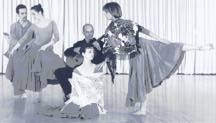Melody And Step Joined
Speaking in Steps: An ensemble moment from Margaret Wingrove's "Voces."
Lyrical moves highlight works by Wingrove dancers and choreographers
By Philip Collins
THE MARGARET Wingrove Dance Company offered up a lovely and curious concoction of dances Friday at West Valley College Theater. Wingrove's lyrical choreography and the lush atmospheres of live guitar and percussion in Voces added up to a transcendent finale. A Binding of Wounds, revived from last year's program, made a welcome return, this time more focused in execution.
Works by two principal dancers--Mirage by Lori Seymour and The Waiting Room by Michael Howerton--added contrast to the evening. Wingrove's intimate weddings between melody and step in Voces and A Binding of Wounds seemed almost prim in comparison to the terse angularities of Seymour's and Howerton's pieces, both of which were accompanied by synthesized pop-music scores.
The eclectic vocabulary of Seymour's choreography coupled well with the ethereal musical meanderings of the group Enigma. As the musical textures evolved through assorted rock beats, Arabic chant and even John Williams' theme to Close Encounters of the Third Kind, Seymour's choreography kept the eyes busy with eight dancers in ever-changing configurations. Scenarios of literal and abstract symbolism flooded the stage with overtones of a harsh reality. Oppression, strife, handball and even the seduction of a priest were among the more memorable images cast.
Howerton's solo dance for Seymour, The Waiting Room, was an exhausting contest of individual tenacity versus the travails of modern existence. The work played with our relationships to time--keeping up with it as well as waiting for it.
There was plenty left to the imagination in Voces, Wingrove's choreographic suite to poems by Octavio Paz and Gabriela Mistral. The seven selected poems, of which only the final one was recited, provided more an emotional blueprint for the work than a narrative. Through perusal of the printed verse in the program prior to the show, one was able to draw upon certain references, but specific correlations between text and choreography were not easily appreciable.
The seven movements flowed seamlessly, and the music never stopped. Sonic varieties by guitarist Coale Johnson and percussionist Edgardo Cambón abounded and contributed generously to the work's pacing. Johnson's command of the bossa nova style--with touches of flamenco--and Cambón's arsenal of percussion instruments blended exquisitely with the verse of Paz and Mistral.
Voces' outer movements featured full ensemble collages, while those between highlighted the company's individual assets. Howerton's solo to the second verse made extended use of the dancer's height and elasticity. Through leaps and stretches that filled the stage, Howerton embodied the poem's opening lines--"At first, there was the extending into the dark, making himself immense in the immense."
With the third segment, a sensual mirror dance by Seymour and Carol Ann Miller, Voces coalesced into its sweetest moments. Paz's corporeal philosophy--"Life and death are not opposite worlds, we are one stem with twin flowers"--was coupled with a sashaying dance motif, reminiscent of bossa nova, except for its slippery 11/8 meter. In the manner of Paz's earthy-yet-dreamlike poetry, the dance theme conjured a mood somewhere between introspection and tenacity.
Graciela Acedo poignantly nursed a broken heart during her solo to "Oh, no! Just to see him again." The dance encompassed stages of vulnerability, longing and anguish, and Acedo's performance arose beautifully out of the music and text. Each gesture was as emotionally informed as it was exacting.
Shawn Perez's bravura in the solo to "Where her house stood" served the suite's most climactic sequence brilliantly. Driven by Cambón's steady stream of drumming and the "fire of her breast," Perez exerted a ferocity that was actually charismatic.
IT WAS a delight to see last year's A Binding of Wounds again. Tightly structured and proportioned handsomely to the contours of Vaughan Williams' string orchestra fantasia, Of Dives and Lazarus, this dance for three women offers spellbinding chemistries of sight and sound, meaning and nonmeaning. Seymour and Miller, reprising their roles from the previous production, found solid rapport with newcomer Laura Sefchovich.
Wingrove's choreography in A Binding of Wounds weaves across and through Vaughan Williams' broad, sweeping phrases in myriad trajectories, and the dancers articulated the choreography's nonstop rigors with aerial grace.
Lisa Pontier's austere set of three silk columns--hung from ceiling to floor and colored in bled shadings of purple, blue, green and gold--created a stunning visual metaphor and the dancers' use of them literally wrapped the evening up into a neat knot.
[ Metro | Metroactive Central | Archives ]
This page was designed and created by the Boulevards team.

Lou Frank Photography
From the August 22-28, 1996 issue of Metro
Copyright © 1996 Metro Publishing, Inc.
![[Metroactive Stage]](/stage/gifs/stage.gif)